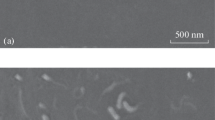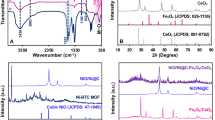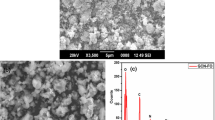Abstract
Hundreds of thousands of people dying from the abuse of fentanyl and its analogs. Hence, the development of an efficient and highly accurate detection method is extremely relevant and challenging. Therefore, we proposed the introduction of oxygen defects into Fe2(MoO4)3 nanoparticles for improving the catalyst performance and combining it with multi-walled carbon nanotubes (MWCNTs) for electrochemical detection of fentanyl and its analogs. Oxygen vacancy–rich Fe2(MoO4)3 (called r-Fe2(MoO4)3) nanoparticles were successfully synthesized and characterized in detail by scanning electron microscopy (SEM), transmission electron microscopy (TEM), energy-dispersive spectrometry (EDS), X-ray diffraction (XRD), Fourier transform infrared (FT-IR), Raman spectra, BET, X-ray photoelectron spectroscopy (XPS), and electron paramagnetic resonance (EPR) and investigated by comparison with oxygen vacancy–poor Fe2(MoO4)3 (called p-Fe2(MoO4)3). The obtained oxygen vacancy–rich Fe2(MoO4)3 was ultrasonically composited with MWCNTs for modification of glassy carbon electrodes (GCEs) used for the electrochemical detection of fentanyl and its analogs. The modified MWCNT-GCE showed ultrasensitivity to fentanyl, sufentanil, alfentanil, and acetylfentanyl with limits of detection (LOD) of 0.006 µmol·L−1, 0.008 µmol·L−1, 0.018 µmol·L−1, and 0.024 µmol·L−1, respectively, and could distinguish among the four drugs based on their peak voltages. Besides, the obtained r-Fe2(MoO4)3/MWCNT composite also exhibited high repeatability, selectivity, and stability. It showed satisfactory detection performance on real samples, with recoveries of 70.53 ~ 94.85% and 50.98 ~ 82.54% in serum and urine for the four drugs in a concentration range 0.2 ~ 1 µM, respectively. The experimental results confirm that the introduction of oxygen vacancies effectively improves the sensitivity of fentanyl electrochemical detection, and this work provides some inspiration for the development of catalytic materials for electrochemical sensors with higher sensitivity.
Graphical Abstract










Similar content being viewed by others
Data availability
The data that support the findings of this study are available from the corresponding author, [Tao, Jin], upon reasonable request.
References
Gecici O, Gokmen Z, Nebioglu M (2010) Fentanyl dependence caused by the non-medical use: a case report. Klinik Psikofarmakoloji Bulteni-Bulletin of Clinical Psychopharmacology 20(3):255–257
Kuhlman JJ, McCaulley R, Valouch TJ, Behonick GS (2003) Fentanyl use, misuse, and abuse: a summary of 23 postmortem cases. J Anal Toxicol 27(7):499–504
Dotsikas Y, Loukas YL, Siafaka I (2002) Determination of umbilical cord and maternal plasma concentrations of fentanyl by using novel spectrophotometric and chemiluminescence enzyme immunoassays. Anal Chim Acta 459(2):177–185
Jelinkova R, Halamek E, Kobliha Z (2015) Extraction-spectrophotometric determination of fentanyl and its derivatives. Chem Listy 109(2):135–139
Roberson ZR, Gordon HC, Goodpaster JV (2020) Instrumental and chemometric analysis of opiates via gas chromatography-vacuum ultraviolet spectrophotometry (GC-VUV). Anal Bioanal Chem 412(5):1123–1128
Choi HS, Shin HC, Khang G, Rhee JM, Lee HB (2001) Quantitative analysis of fentanyl in rat plasma by gas chromatography with nitrogen-phosphorus detection. J Chromatogr B: Anal Technol Biomed Life Sci 765(1):63–69
Goldberger BA, Chronister CW, Merves ML (2010) Quantitation of fentanyl in blood and urine using gas chromatography-mass spectrometry (GC-MS) In Clinical Applications of Mass Spectrometry: Methods and Protocols, Garg, U.; HammettStabler, C. A., Eds. Vol. 603, pp 245–252
Malkawi AH, Al-Ghananeem AM, Crooks PA (2008) Development of a GC-MS assay for the determination of fentanyl pharmacokinetics in rabbit plasma after sublingual spray delivery. Aaps J 10(2):261–267
Montanari S, Davani L, Terenzi C, Maltoni M, Andrisano V, De Simone A, Ricci M (2022) Fentanyl pharmacokinetics in blood of cancer patients by gas chromatography - mass spectrometry. J Pharm Biomed Anal 219:114913
Kumar K, Morgan DJ, Crankshaw DP (1987) Determination of fentanyl and alfentanil in plasma by high-performance liquid-chromatography with ultraviolet detection. J Chromatogr B Biomed Appl 419:464–468
Portier EJG, de Blok K, Butter JJ, van Boxtel CJ (1999) Simultaneous determination of fentanyl and midazolam using high-performance liquid chromatography with ultraviolet detection. J Chromatogr B 723(1–2):313–318
Takashina Y, Naito T, Mino Y, Kagawa Y, Kawakami J (2009) Validated LC coupled to ESI-MS/MS analysis for fentanyl in human plasma and UV analysis in applied reservoir transdermal patches using a simple and rapid procedure. J Clin Pharm Ther 34(5):523–529
Lurie IS, Iio R (2009) Use of multiple-reaction monitoring ratios for identifying incompletely resolved fentanyl homologs and analogs via ultra-high-pressure liquid chromatography-tandem mass spectrometry. J Chromatogr A 1216(9):1515–1519
Angi C, Lurie IS, Marginean I (2019) Analysis of fentanyl derivatives by ultra high performance liquid chromatography with diode array ultraviolet and single quadrupole mass spectrometric detection. J Sep Sci 42(9):1686–1694
Wang H, Zhao XY, Shang YZ, Wang H, Wang P, Yu XX (2021) Quantitative analysis of 20 fentanyl analogues by modified QuEChERSLC-MS/MS in health products and transdermal patches J Pharm Biomed Anal 201
Xie Y, Gao F, Tu XL, Ma X, Dai RY, Peng GY, Yu YF, Lu LM (2019) Flake-like neodymium molybdate wrapped with multi-walled carbon nanotubes as an effective electrode material for sensitive electrochemical detection of carbendazim. J Electroanal Chem 855:113468
Mariyappan V, Jeyapragasam T, Chen SM, Murugan K (2021) Mo-W-O nanowire intercalated graphene aerogel nanocomposite for the simultaneous determination of dopamine and tyrosine in human urine and blood serum sample. J Electroanal Chem 895:115391
Baby JN, Sriram B, Wang SF, George M (2021) Integration of samarium vanadate/carbon nanofiber through synergy: an electrochemical tool for sulfadiazine analysis. J Hazard Mater 408:124940
Govindasamy M, Chen SM, Mani V, Devasenathipathy R, Umamaheswari R, Santhanaraj KJ, Sathiyan A (2017) Molybdenum disulfide nanosheets coated multiwalled carbon nanotubes composite for highly sensitive determination of chloramphenicol in food samples milk, honey and powdered milk. J Colloid Interface Sci 485:129–136
Hu N, Guo H, Lin S (1994) Adsorptive stripping voltammetry of a fentanyl derivative at a mercury electrode. Talanta 41(8):1269–1274
Peng LJ, Wen ML, Yao Y (2001) Construction and performance characteristics of new fentanyl-selective plastic membrane electrode. Anal Sci 17(7):815–818
Goodchild SA, Hubble LJ, Mishra RK, Li Z, Goud KY, Barfidokht A, Shah R, Bagot KS, McIntosh AJS, Wang J (2019) Ionic liquid-modified disposable electrochemical sensor strip for analysis of fentanyl. Anal Chem 91(5):3747–3753
Barfidokht A, Mishra RK, Seenivasan R, Liu S, Hubble LJ, Wang J, Hall DA (2019) Wearable electrochemical glove-based sensor for rapid and on-site detection of fentanyl. Sens Actuators, B Chem 296:126422
Naghian E, Khosrowshahi EM, Sohouli E, Ahmadi F, Rahimi-Nasrabadi M, Safarifard V (2020) A new electrochemical sensor for the detection of fentanyl lethal drug by a screen-printed carbon electrode modified with the open-ended channels of Zn(ii)-MOF. New J Chem 44(22):9271–9277
Sohouli E, Keihan AH, Shahdost-fard F, Naghian E, Plonska-Brzezinska ME, Rahimi-Nasrabadi M, Ahmadi F (2020) A glassy carbon electrode modified with carbon nanoonions for electrochemical determination of fentanyl. Mater Sci Eng. C 110:110684
Ding H, Tao W (2021) Synthesis of NiO-CNTs nanocomposite for modification of glassy carbon electrode and application for electrochemical determination of fentanyl as an opioid analgesic drug Int J Electrochem Sci 16 (11)
Mishra RK, Krishnakumar A, Zareei A, Heredia-Rivera U, Rahimi R (2022) Electrochemical sensor for rapid detection of fentanyl using laser-induced porous carbon-electrodes Microchimica Acta 189 (5)
Wester N, Mynttinen E, Etula J, Lilius T, Kalso E, Mikladal BF, Zhang Q, Jiang H, Sainio S, Nordlund D, Kauppinen EI, Laurila T, Koskinen J (2020) Single-walled carbon nanotube network electrodes for the detection of fentanyl citrate. Acs Applied Nano Materials 3(2):1203–1212
Amiri M Eskandari K Salavati-Niasari M (2019) Magnetically retrievable ferrite nanoparticles in the catalysis application. Adv Colloid Interface Sci 271:100552
Monsef R, Salavati-Niasari M (2022) Electrochemical sensor based on a chitosan-molybdenum vanadate nanocomposite for detection of hydroxychloroquine in biological samples. J Colloid Interface Sci 613:1–14
Zinatloo-Ajabshir S, Baladi M, Salavati-Niasari M (2021) Enhanced visible-light-driven photocatalytic performance for degradation of organic contaminants using PbWO4 nanostructure fabricated by a new, simple and green sonochemical approach. Ultrason Sonochem 72:105420
Amiri M, Salavati-Niasari M, Akbari A, Gholami T (2017) Removal of malachite green (a toxic dye) from water by cobalt ferrite silica magnetic nanocomposite: herbal and green sol-gel autocombustion synthesis. Int J Hydrogen Energy 42(39):24846–24860
Zinatloo-Ajabshir S, Ghasemian N, Mousavi-Kamazani M, Salavati-Niasari M Effect of zirconia on improving NOx reduction efficiency of Nd2Zr2O7 nanostructure fabricated by a new, facile and green sonochemical approach Ultrason Sonochem 2021 71
Xie JF, Zhang H, Li S, Wang RX, Sun X, Zhou M, Zhou JF, Lou XW, Xie Y (2013) Defect-Rich MoS2 Ultrathin Nanosheets with Additional Active Edge Sites for Enhanced Electrocatalytic Hydrogen Evolution. Adv Mater 25(40):5807
Yin Y, Han J, Zhang Y, Zhang X, Xu P, Yuan Q, Samad L, Wang X, Wang Y, Zhang Z, Zhang P, Cao X, Song B, Jin S (2016) Contributions of phase, sulfur vacancies, and edges to the hydrogen evolution reaction catalytic activity of porous molybdenum disulfide nanosheets. J Am Chem Soc 138(25):7965–7972
Guo YQ, Xu K, Wu CZ, Zhao JY, Xie Y (2015) Surface chemical-modification for engineering the intrinsic physical properties of inorganic two-dimensional nanomaterials. Chem Soc Rev 44(3):637–646
Wang FM, He P, Li YC, Shifa TA, Deng Y, Liu KL, Wang QS, Wang F, Wen Y, Wang ZX, Zhan XY, Sun LF, He J (2017) Interface engineered WxC@WS2 nanostructure for enhanced hydrogen evolution catalysis Adv Funct Mater 27 (7)
Xie J, Zhang J, Li S, Grote F, Zhang X, Zhang H, Wang R, Lei Y, Pan B, Xie Y (2013) Controllable disorder engineering in oxygen-incorporated MoS2 ultrathin nanosheets for efficient hydrogen evolution. J Am Chem Soc 135(47):17881–17888
Xu K, Chen P, Li X, Tong Y, Ding H, Wu X, Chu W, Peng Z, Wu C, Xie Y (2015) Metallic nickel nitride nanosheets realizing enhanced electrochemical water oxidation. J Am Chem Soc 137(12):4119–4125
Stern LA, Feng LG, Song F, Hu XL (2015) Ni2P as a Janus catalyst for water splitting: the oxygen evolution activity of Ni2P nanoparticles. Energy Environ Sci 8(8):2347–2351
Guo YQ, Tong Y, Chen PZ, Xu K, Zhao JY, Lin Y, Chu WS, Peng ZM, Wu CZ, Xie Y (2015) Engineering the electronic state of a perovskite electrocatalyst for synergistically enhanced oxygen evolution reaction. Adv Mater 27(39):5989–5994
Lei F, Sun Y, Liu K, Gao S, Liang L, Pan B, Xie Y (2014) Oxygen vacancies confined in ultrathin indium oxide porous sheets for promoted visible-light water splitting. J Am Chem Soc 136(19):6826–6829
Tian SH, Tu YT, Chen DS, Chen X, Xiong Y (2011) Degradation of acid orange II at neutral pH using Fe2(MoO4)3 as a heterogeneous Fenton-like catalyst. Chem Eng J 169(1–3):31–37
Mir N, Salavati-Niasari M (2013) Preparation of TiO2 nanoparticles by using tripodal tetraamine ligands as complexing agent via two-step sol-gel method and their application in dye-sensitized solar cells. Mater Res Bull 48(4):1660–1667
Shit S, Bolar S, Kolya H, Kang CW, Murmu NC, Kuila T (2022) Assisting the formation of S-doped FeMoO4 in lieu of an iron oxide/molybdenum sulfide heterostructure: a unique approach towards attaining excellent electrocatalytic water splitting activity. Int J Hydrogen Energy 47(21):11128–11142
Singh RN, Madhu, Awasthi R, Tiwari SK (2009) Iron molybdates as electrocatalysts for O2 evolution reaction in alkaline solutions. Int J Hydrog Energy 34(11):4693–4700
Sejkora J, Cejka J, Malíková R, López A, Xi YF, Frost RL (2014) A Raman spectroscopic study of a hydrated molybdate mineral ferrimolybdite, Fe2(MoO4)3•7-8H2O. Spectrochim Acta A Mol Biomol Spectrosc 130:83–89
Li D, Xue JQ, Ma J, Tang JL (2016) Synthesis of Fe2(MoO4)3/MoO3 heterostructured microrods and photocatalytic performances. New J Chem 40(4):3330–3335
Biesinger MC, Payne BP, Grosvenor AP, Lau LWM, Gerson AR, Smart RS (2011) Resolving surface chemical states in XPS analysis of first row transition metals, oxides and hydroxides: Cr, Mn, Fe Co and Ni. Appl Surf Sci 257(7):2717–2730
Soares APV, Portela MF, Kiennemann A, Hilaire L, Millet JMM (2001) Iron molybdate catalysts for methanol to formaldehyde oxidation: effects of Mo excess on catalytic behaviour. Appl Catal A-General 206(2):221–229
Grissa R, Martinez H, Pelé V, Cotte S, Pecquenard B, Le Cras F (2017) An X-ray photoelectron spectroscopy study of the electrochemical behaviour of iron molybdate thin films in lithium and sodium cells. J Power Sources 342:796–807
Tong Y, Chen PZ, Zhang MX, Zhou TP, Zhang LD, Chu WS, Wu CZ, Xie Y (2018) Oxygen vacancies confined in nickel molybdenum oxide porous nanosheets for promoted electrocatalytic urea oxidation. ACS Catal 8(1):1–7
Glasscott MW, Vannoy KJ, Fernando P, Kosgei GK, Moores LC, Dick JE (2020) Electrochemical sensors for the detection of fentanyl and its analogs: foundations and recent advances Trends Analyt Chem 132
Jun DN, Sammis G, Rezazadeh-Azar P, Ginoux E, Bizzotto D (2022) Development of a graphene-oxide-deposited carbon electrode for the rapid and low-level detection of fentanyl and derivatives. Anal Chem 94(37):12706–12714
Zhu DD, Guo CX, Liu JL, Wang L, Dub Y, Qiao SZ (2017) Two-dimensional metal-organic frameworks with high oxidation states for efficient electrocatalytic urea oxidation. Chem Commun 53(79):10906–10909
Zhao Z, He Y, Qi X, Li N, He Z, Chen Y, Jin T (2023) A series of ultrasensitive electrocatalysts Fe-MOF/MWCNTs for fentanyl determination. Analyst 148(8):1838–1847
Zhao ZD, He Y, Qi XR, Li N, He ZJ, Liu B, Lai HJ, Chen YF, Jin T (2023) Synthesis of nanoflower-like NiMnO3 combined with MWCNTs for the electrochemical determination of fentanyl. Electrochimica Acta 462:142747
Funding
The authors would like to thank the National Natural Science Foundation of China (No. 42063002) and Guizhou Provincial Key Technology R&D Program (No. [2023] General 441) for their financial support.
Author information
Authors and Affiliations
Corresponding author
Ethics declarations
Ethics approval and consent to participate
All experiments were performed strictly in accordance with the guidelines of the National Health Commission of China and approved by the ethics committee at Guangzhou Institute of Chemistry, Chinese Academy of Sciences. Informed consents were obtained from human participants of this study.
Conflict of interest
The authors declare no competing interests.
Additional information
Publisher's Note
Springer Nature remains neutral with regard to jurisdictional claims in published maps and institutional affiliations.
Supplementary Information
Below is the link to the electronic supplementary material.
Rights and permissions
Springer Nature or its licensor (e.g. a society or other partner) holds exclusive rights to this article under a publishing agreement with the author(s) or other rightsholder(s); author self-archiving of the accepted manuscript version of this article is solely governed by the terms of such publishing agreement and applicable law.
About this article
Cite this article
Zhao, Z., Qi, X., He, Y. et al. Oxygen vacancy–rich Fe2(MoO4)3 combined with MWCNTs for electrochemical sensors of fentanyl and its analogs. Microchim Acta 191, 159 (2024). https://doi.org/10.1007/s00604-024-06222-6
Received:
Accepted:
Published:
DOI: https://doi.org/10.1007/s00604-024-06222-6




